|

Astronomical Clock of Prague
Bonnie Moss (c)September,2013
Astronomical Clock of Prague
...tick,tock,tick,tock...
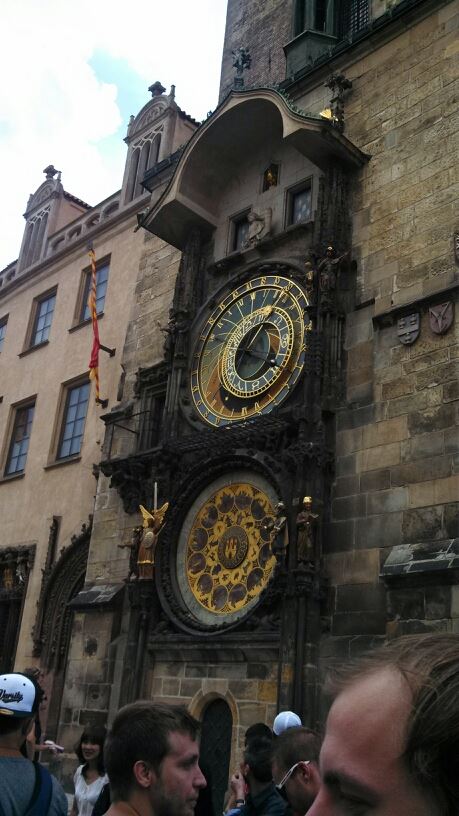
A visit to Prague is not complete without
a visit to the astronomical clock, surrounded
by legends and stories. The oldest and most
celebrated clock is on the side wall of the
Old Town Hall. With glittering hands and a
complex series of filigreed wheels, this
ornamental timepiece doesn't merely mark
the hours.
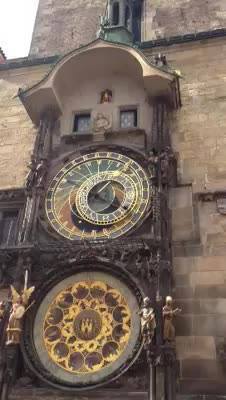
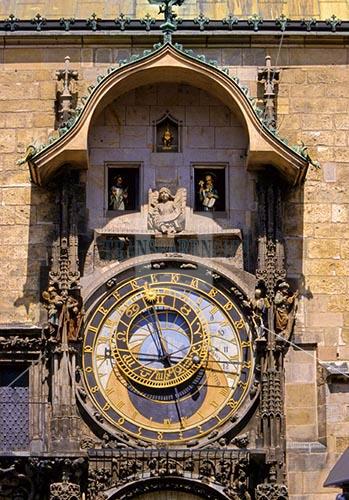
Symbols of the zodiac tell the course of the heavens.
When the bell tolls, windows fly open and mechanical apostles,
skeletons, and "sinners" begin a ritualistic dance of destiny.
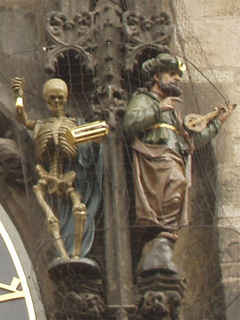

When the clock strikes the hour,
these figures of Vanity,
Greed, Death and Desire
come alive.Images around
the clock:
Vanity represented
with a mirror.
Greed represented
by a purse of money
Death represented by
a skeleton holding a bell
Desire, represented by
a Turkish holding a mandolin.
The Prague Astronomical Clock is one of the oldest European
clocks of its kind. The first ever was made in Padua in 1344,
a second one in Strassburg in 1354.The Prague Astronomical
clock is unique in being the oldest of those where the original
clockwork has been in operation from the beginning to the
present time for six centuries
The astrological dial shaped like as astrolab survives in the
original form. Interestingly,the Clock showed exclusively
astronomical data. At that time, there were no mechanical
figures to entertain but only the pure art of Astronomy.
Ref: J.Podolsky, Dec. 1997
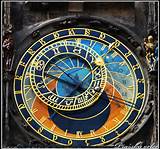

This Clock offers the
visitor a moment of
mystery, magic and
mysticism. A number
of legends about this
clock adds to the mystery.
It was believed that it
was built around 1490 by a
clockmaker Jan Ruze ( Hanus) and his assistant
Jakub Cech.Fictitious legends surround the Clock- in
recent times, it is believed that it was made earlier,
in 1410, constructed by the clockmaker Mikulas of Kadan,
with the help of Jan Ondrejuv (Sindel) who was a
professor of Mathematics and Astronomy of
Prague Charles University.
Jack Craven,About.com writes:
They say everything in Prague has a story, and so it is with
the Old Town clock. Natives claim that when the mechanical
figures were created, town officials had the clockmaker blinded
so that he would never duplicate his masterpiece. In vengeance,
the blind man climbed the tower and stopped his creation. The
clock remained silent for more than fifty years. Centuries later,
during dreary decades of communist domination, the legend
of the blinded clockmaker became a Metaphor for
thwarted creativity.
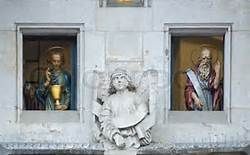
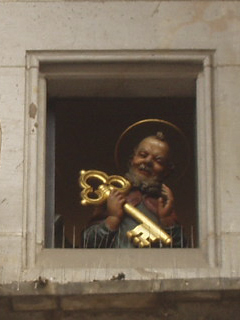
The astronomical dial
(astrolabe on the clock face)
still works today. It is
believed that in the second
phase of making the clock,
probably around 1490, a calendar dial was added
under the astronomical dial. During that time, the
front of the clock was richly adorned with
Vladislav Gothic stone sculptures.
Worthy of note: at the beginning of the 15th century, the sculpture
around the astronomical dial and mask and figures were created
by members of the Masonic Lodge of stone masons and sculptor
led by Peter Parker.

Added in the nineteenth century,this
ornamental timepiece doesn't merely
mark the hours. Symbols of the zodiac
tell the course of the heavens. The irony
of the Prague Astronomical Clock is that
for all its mastery at keeping time,
it is nearly impossible to place in time.
The figures of the twelve apostles that pass
along the two little windows every hour of
daylight were added after major repair work
in 1865-1866. During this repair a new calendar
disc was installed made by well-known Czech
painter Josef Manes. Add to his work the cycle
of twelve medallions of the Month and the zodiacal signs.
Finally to end the animation, a window opens with a
rooster that crows to announce the death. The rooster
was added in 1882. There is also the top of the clock
men who are playing the trumpet.
Stationary statues:
The other statues, that donīt move, are an Astronomer, a Chronicler,
a Philosopher and an Angel.These are symbolic- man is almost
oblivious to the contributions of these figures , except for those with
keen interests and study these topics.

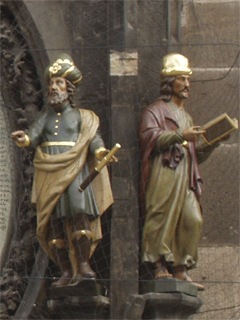
Added in the nineteenth century,this
ornamental timepiece doesn't merely
mark the hours. Symbols of the
zodiac tell the course of the
heavens. The irony of the Prague
Astronomical Clock is that for all its
mastery at keeping time, it is nearly
impossible to place in time.
A Philosopher`s words can be ignored
in his lifetime, yet lives on many centuries
later. We do not see Angels- yet many
of us believe in their presence- to guide,
to protect, to inspire man. Think about
it- it is the battle between Good and Evil,
Life and Death. This was pertinent then
back to the Biblical Times and still holds
true today, into the 21st century.
The Clock was heavily damaged in the last days
of World War Two. The Nazis directed artillery fire
at the the Old Town Hall and also used hand grenades.
The whole building burnt down and with it were the
complete City archives.
However, some self-sacrificing persons managed
to repair hte authentic old clockwork, restoring the
Astronomical Clock in its original form.
Lois Kramer writes:
The clock continues to fascinate and remain fascinating,
despite the repairs. It seems unique in its old technology
and full of religious symbols. The clock always surprises
the technical prowess of the time it took to achieve and
the wealth of information it can disclose if we can read it.
The Mechanical Aspects of the Clock:
Read arrows of time
You can read all this information with the Astronomical Clock:
- Local time designated by the golden hand over the Roman numerals
- The twelfth hour day, designated by the position of the sun on
golden curves
- Time in hours old Czech designated by the hand on the golden
Gothic numerals
- The position of the Sun
- The position of the Moon
- Moon phase
- Astrological zodiac sign
- Sidereal time, indicated by the small gold star
The astronomical dial
The astronomical dial is the main dial, it has the shape
of an astrolabe. An astrolabe in its Greek etymology is a
tool to take the height of the stars and can therefore
represent the movement of the stars.
In the dial four components are moving:
- external rotary circle
- zodiacal circle
- a Sun moves a needle to a golden hand
- a Moon which is located on another needle
A magical tour, ending it with an early and relaxing dinner at
El Toro Negro- complete with dessert and a bottle of wine.


To end the exciting day- a night out at the Hilton Prague Cloud 9 Bar

Curious crowd at the Prague Astronomical Clock

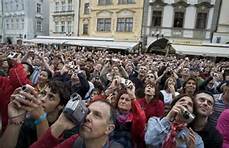 Human Interest
ARTICLE ARCHIVE
INDEX
Human Interest
ARTICLE ARCHIVE
INDEX
|
 |
|
|
HOME |
|
|
|
